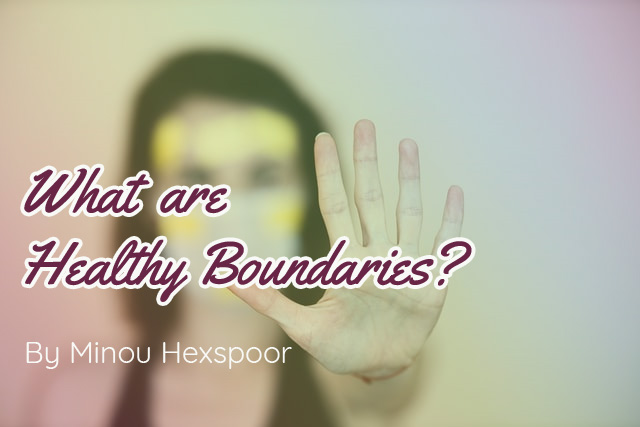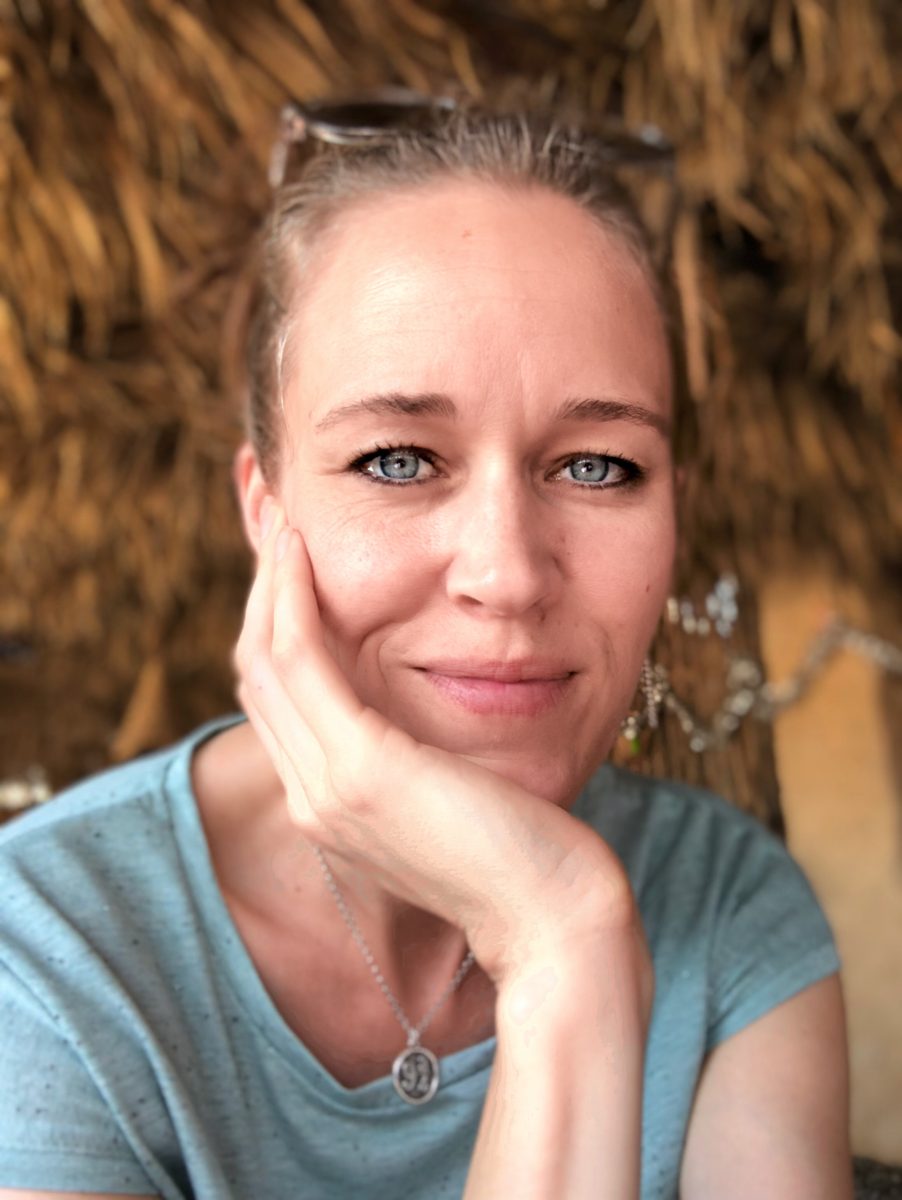
Healthy boundaries are key to happiness and wellbeing, especially when overwhelm and stress are regular visitors in your life.
Boundaries.
We all have them, in one way or another, yet they do not look the same for everyone. That poses some challenges, because how do you know if your boundaries are working for you and can be considered ‘healthy’? What exactly are healthy boundaries and how can you make sure that you live by them?
In this article, I will explain what the general definition of ‘boundary’ is, what causes you to set certain boundaries, what description of ‘boundaries’ I like to use and how you can spot the signals of having unhealthy boundaries. Also, I’ll share a couple of practical tips that can help you define your (unhealthy) boundaries and transform them into healthy ones.
Personal space & acceptable behaviour
General definition
Let me start by sharing the general, well-known definition of ‘boundary’ with you. The general definition of ‘boundary’ or ‘boundaries’ according to the Cambridge Dictionary is as follows:
1. a real or imagined line that marks the edge or limit of something;
2. the limit of a subject or principle;
3. the limit of what someone considers to be acceptable behaviour.
When looking at this definition, having healthy boundaries can translate to a couple of different things, such as thinking about where your personal space stops, and another’s personal space starts (see definition 1), or having a healthy view on what you consider to be acceptable behaviour or not (see definition 3).
Both these definitions contribute to what I consider to be healthy boundaries.
For me, the definition of what ‘healthy boundaries’ are exactly has a much broader, extensive meaning. But before I am going into the description I usually rely on when working with my clients, I want to explain to you how boundaries tend to arise and how they are kept in place by you and those around you.
After all, what you consider to be acceptable behaviour all depends on the (behavioural) patterns that you have developed since your childhood and have brought along with you into adulthood.

You are your own gatekeeper
In psychological terms, boundaries are a conceptual limit between you and another person. In other words, it is about knowing who you are and who others are, what’s yours and what’s not, and what it is you are responsible for.
According to Scott’s personal space theory (1993), all of us have boundaries and we are able to regulate how permeable they are – what we let in and what we let out – when it comes to our personal, mental and spiritual environment.
Peck (1997) compares this with being the gatekeeper of your own castle; if you keep the front door unlocked and the drawbridge down, anyone can walk right in, whilst no one can enter if you keep the drawbridge drawn and your doors firmly closed.
Therefore, you can compare having healthy boundaries with knowing when to lower the drawbridge and open the door and knowing when to keep your gates shut, depending on the people and the situation you’re dealing with. It is this ability to be able to decide whether to let people in that helps define what is or isn’t a healthy boundary.
Let’s say you tend to keep your gates closed and shut people out, no matter what they’re like or what the situation is like. Arguably, there is a reason you don’t trust them enough to let them in. Or maybe you have your drawbridge down and your gates open all the time, letting people come in whenever they want.
Perhaps this is because you don’t want to tell them ‘no’ in fear of being rude or because you have no clue when and how to hoister up that drawbridge.
These thought and behavioural patterns possibly stem from your childhood, which is the period in which we define our own boundaries based on our own experiences. As an infant, you are reliant on your parents.
You bond with them emotionally, observe everything they do and adopt their manners, feelings and belief systems within the context that you grow up in. Our parents aren’t perfect; they have their own patterned ways of being that they too have learned during their childhood and adult life.
That’s why we learn from and adopt both their positive and negative (or facilitating and hindering) ways of feeling, thinking and behaving, which are called ‘patterns’. These patterns can result in unwanted consequences, because we often adopt them without questioning their effectiveness.
They include beliefs, perceptions, judgments, needs and desires about most aspects in life, such as how to get love and approval and how to relate to others. It is important for children to learn about boundaries from their parents, because parents function as the first stepping stone as to how an individual gradually learns the vast set of written and unwritten rules that make up our society.
In short, the boundaries that we learn at home during our childhood are the first exposure we have to the outside world.
Being raised with a set of healthy boundaries helps us to deal with different types of social situations as we grow older.
As we mature, we take on different ways of handling what is unknown to us and protect ourselves from what we believe is dangerous.
The ways in which we deal with unknown situations or protect ourselves from dangerous ones – by retracting ourselves from uncomfortable situations, not daring to say “no” when someone asks us for help, etc. – will become so natural to us that we take them with us when growing into adulthood.

The result? You keep falling back to this, often unhealthy, behaviour, thus not being able to set clear and healthy boundaries for yourself.
A new definition of healthy boundaries
Of course, the definition that we have discussed so far generally defines a healthy boundary from a black and white perspective: where does it stop and where does it start. But to really tackle the issues that many of my clients encounter when trying to set healthy boundaries, and really help them create change at the core, I define boundaries as follows:
Our boundaries are the perimeters of an ever expanding and rescinding space within which we allow ourselves to express who we believe to be in the world around us at any moment.
The boundaries we create define the playground within which we can choose our experiences.
They inform the realities we experience with ourselves and others. They facilitate (or hinder) what we desire to express, feel, and do, and what we allow ourselves to discover about who we really want to be through conscious choice.
The more we grow, the more our playground expands and allows us to fully express ourselves with authenticity, intuition, and joy.
The reason why I like to rely on this particular description is because it shows that our boundaries are not set in stone and can expand (and rescind) with us.
Therefore, the responsibility to set these boundaries to fit our own needs is our own, not somebody else’s. This definition taps into our feelings and our experiences and, in this way, can help us grow and flourish, instead of limit us.
This definition allows you to take the reins in your own hands and be in charge of your own life and how you live it, without having to feel overwhelmed, compromised and disrespected.
The Seven Pillars of Healthy Boundaries
To illustrate what this definition can look like when put into practice, I’ll briefly discuss the Seven Pillars of Healthy Boundaries with you. These Seven Pillars each represent a stage of boundary-setting that proves important when transforming your unhealthy boundaries to healthy ones. Let me lay them out for you:
1. Heal the Hurt: This first pillar is all about letting go of the thought that your boundaries will never be respected.
Whether it is because you’re afraid to set boundaries or whether you don’t really know what your boundaries look like and how to communicate them effectively, by not dealing with this pillar, you run the risk of become stuck in fear, guilt, bitterness and self-blame, which does not help to come to a place where you can set boundaries that will help you take back ownership over certain relations or your life in general.
2. Rouse the Rebel: This second pillar is there to help you understand the role that anger plays in relation to (the absence) of your boundaries and your belief that you have to fight for people to respect your boundaries.
Without dealing with this pillar, you run the risk of becoming generally angry with the world around you, feeling misunderstood and provoked all the time, which will only confirm your belief of having to fight for yourself.
3. Mind the Mind: This third pillar is about believing that you can manage your boundaries, about discovering the relationship between your mind, why you set boundaries and how you do that.
It will also help you evaluate how you cope with situations during which your boundaries aren’t respected and how that benefits you (or not). If you don’t deal with this pillar, you tend to let others cross your boundaries without standing up to them or hold yourself back from actually creating those boundaries.
4. Care with Compassion: This fourth pillar is particularly about caring about your own boundaries and those of others.
What role does care for and support to others play in your life? If this pillar is neglected, you run the risk of over-giving, which can lead to you feeling drained and depleted because your boundaries are not providing for the care or support you need yourself.
5. Opt for Opportunity: This fifth pillar is about realizing that your boundaries can provide you with opportunities.
This is a really exciting pillar, since it shows you what you can create for yourself when setting healthy boundaries. Not investing in this pillar will result in having expansive boundaries that can have you feeling overwhelmed and unable to materialize all the ideas or even dreams that you have.
6. Jam with Joy: With this sixth pillar, I inspire you to experience joy through setting those healthy
boundaries and seeing how they evolve with you as you grow.
You will learn how to intuitively know and communicate your boundaries from a state of flow and joy. If you don’t address this pillar, you might end up missing out on creating boundaries that sustain your true purpose, spiritual growth and finding real value in life.
7. Play with Passion: Last but not least, the seventh pillar will teach you how to use your boundaries as a means to express your passions.
You can play with your boundaries and explore what potential realities it can provide you with. If you don’t do so, you might miss out on connecting with who you truly are, what your passions are and how to manifest those within the life you chose to live.

Signals of not having healthy boundaries
All of that being said: how do you know that the boundaries that you have set are not particularly healthy and, therefore, beneficial to you, your work life and your self-actualization in general?
When you struggle with setting healthy boundaries, you are probably familiar with some (or many) of the consequences. Think of things like a lack of selfcare, feeling a lack of support for your needs, risk of burnout, reduced mental and emotional health, work-life balance problems, feelings of guilt, anger or a continuous stream of worries, challenging relationships and friendships, and much more.
You might struggle with the influence the behaviour of others has on your life, experience a lack of identity and autonomy (who you are and your freedom to independent living and decision-making) and you most probably are very familiar with taking responsibility for or bearing consequences that belong to others.
Healthy boundaries are key to happiness and wellbeing, especially when overwhelm and stress are regular visitors in your life. Sometimes it might feel counter-intuitive to set boundaries when you are used to always showing up and supporting everyone.
Truth is that setting healthy boundaries helps you stay close to yourself, close to what’s important to you and what your values are all about.
And, of course, it helps others to understand how to honour and respect that. Healthy boundaries are the conscious awareness about and ability to put in place what needs to be honoured and adhered to by yourself and others, so you can live a life in which you can flourish.
Curious as to how (un)healthy your current boundaries are?
With my Ideal Boundaries Tool you can use the Seven Pillars of Healthy Boundaries to check them and improve them if possible!
How To Set Healthy Boundaries
When looking at the Seven Pillars of Healthy Boundaries, it shows that some boundaries are indeed there to help us protect ourselves, while others are about helping us create what I like to call the Playground of Life.
It is only when we master the ability to set boundaries in pillars 1, 2 and 3, that we allow ourselves more and more to create fulfilling lives with joyful playgrounds using pillars four to seven.
Everyone experiences the definition of and needs for boundaries differently based on where they are at in life, what they are going through and what they are learning about themselves and their own boundaries while on their journey through life.

However, all of these boundaries revolve around the same areas of our lives. When we look at how our boundaries are functioning in different relationships, life situations, work situations, etc., we can explore them to understand what is serving us and what isn’t.
That allows us to find out how we can be the best versions of ourselves, honour our own wellbeing and how we can use our boundaries for our personal growth. But how do you do that exactly?
Let me walk you through a few steps of the process.
Self-protection
First of all, you explore the boundaries that serve to provide you with self-protection.
You will not just need to discover how setting boundaries can protect you from getting hurt or ending up in situations that aren’t serving you, but you also learn to see how creating boundaries can help you get support from others when you need it.
This type of boundaries will help you to start addressing situations and relationships in your life that need to heal or that need to change.
That requires you to connect with your inner rebel to find the motivation and strength to actually act upon the decisions that you (need or want to) make.
This will incite your inner power, which I like to refer to as your Inner Rebel, who can help you create the boundaries you need in your life in order to prevent you from feeling stuck or unsafe. Do you notice that you feel angry, worried or fearful a lot?
Exploring self-protecting boundaries will help you identify when fear for consequences is holding you back from freeing yourself from what limits you. It will allow you to transform it into the power you need for setting healthy boundaries and liberate yourself from unwanted expectations.
Strategy
Second, you will dive into your strategic boundaries, which are the ones we put in place to shape our lives and work environment in daily life.
After all, it is important to realise that your boundaries can contribute to healthy and productive environments at both work and home. Your mind is a very strong tool and it can help you to create the boundaries you need, to make sure you don’t end up being hurt or angry.
Therefore, you will uncover ways to avoid, block or release what is holding you back from creating those healthy boundaries.
That includes discovering why and when it is important to set those boundaries when you are taking care of or supporting others, but also outlining your relationship with self-care and learning how to take care of yourself by honouring your own boundaries.
In this way, you can find out what true belonging and acceptance look and feel like, all thanks to healthy boundaries that serve your wellbeing in a world full of opportunities.
Transcendence
Last but not least, somewhat like the Maslow pyramid, you’ll explore how you shape your boundaries to allow you to transcend yourself, so you can truly grow, learn and develop yourself into the human being you want to be; a human being living with purpose and fulfilment.
This part of the process is all about realising you have a choice and actually making that choice. How to do so? Explore how you can optimize your boundaries so opportunities in life can flourish into fruition.
Define them to outline your own Playground, in which you feel powerful, engaging, peaceful and fulfilled. How do these boundaries set the Playground within which you can choose and create your own life experiences?
Create your own Playground and choose how you want to experience yourself within it by consciously choosing your own boundaries.
They can allow you to facilitate deep connections with others, entertain what you’re truly passionate about and evoke inspiration and growth in both your personal and professional life. Allow yourself to learn from all your experiences, guided by your healthy boundaries.
Setting healthy boundaries is a different type of process for everybody, and, therefore, takes a different amount of time. It is okay if it takes you a little bit longer to establish, and to discover what those boundaries that benefit you actually are and how you can effectively communicate them to those around you. And if you are struggling, try using the Ideal Boundaries Tool to help you shift your mindset and transform your boundaries to healthier ones that help you flourish and live your life the way you want to!


